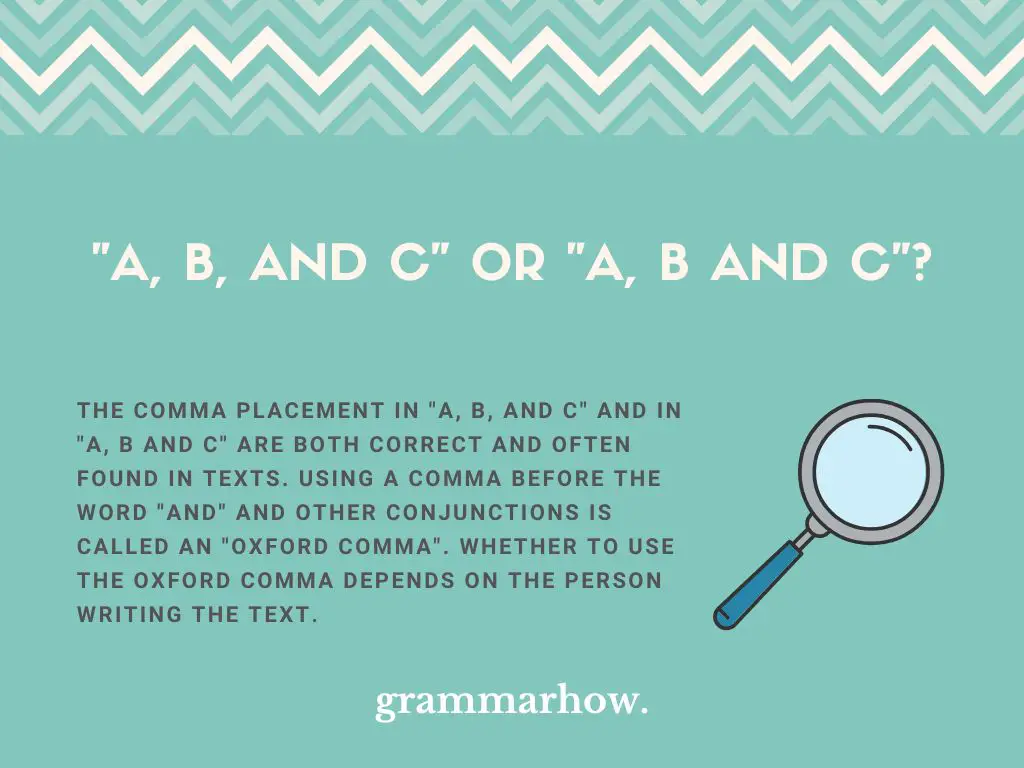Confused about comma rules when writing down a list? Then this article is for you!
“A, B, and C” or “A, B and C”?
The comma placement in “A, B, and C” and in “A, B and C” are both correct and often found in texts. Using a comma before the word “and” and other conjunctions is called an “Oxford comma”. Whether to use the Oxford comma depends on the person writing the text.

Commas are used to separate things in a list. In a list, the last item is typically set apart using a conjunction, such as “and” and “or”.
Putting a comma before the conjunction in a list is called an Oxford comma. Choosing to use an Oxford comma and choosing not to are both considered grammatically correct. For example:
- My friends are Natalie, Jason and Marcus
- My friends are Natalie, Jason, and Marcus
The above sentences are interchangeable with one another as there is little difference in the meaning of the two sentences. In these cases, it really depends on the person writing the text whether an Oxford comma will be used.
However, there are those who recommend that an Oxford comma be used to prevent confusion in lists such as:
- For lunch, he had chicken, rice and milk.
- For lunch, he had chicken, rice, and milk.
In the first sentence where the Oxford comma is not used, the words “rice” and “milk” are lumped together. This makes it seem like the rice was mixed in with the milk. Meanwhile, in the second sentence, “chicken”, “rice”, and “milk” are all treated as equal, separate entities.
In these cases where the meaning may be changed with the presence of the comma before the conjunction, it is recommended to use the option that clearly expresses the intended meaning.
A, B, and C
In a list, using a comma before the conjunction is called an Oxford comma. This is one correct way to separate items in a list.
Using the Oxford comma in a list can take the following forms:
- A, B, and C
- A, B, or C
It is characterized by the use of a comma before a conjunction (usually “and” or “or”). Using the Oxford comma is usually optional; however, its use is recommended in cases where not using a comma changes the meaning of the sentence.
Below are some examples of how to use the Oxford comma in a sentence:
- Millicent enjoys fantasy, mystery, and romance novels.
- What do you want to order for dinner: pizza, chicken, or noodles?
- Don ordered brown, green, and red versions of his favorite shirt.
- Caroline dated Ken, James, and Carlos back in high school.
- Who are you voting for in the elections: Lila, Mike, or John?
A, B and C
When writing down a list, you can opt not to put a comma before the conjunction. This is one correct way to separate items in a list.
You can choose not to put in a comma before the conjunction when listing down items. This can take the following forms:
- A, B and C
- A, B or C
It should be noted, however, that not putting in a comma before the conjunction may sometimes cause confusion about the relationship between items B and C.
Below are some examples of how to use this in a sentence:
- Those who are confirmed to come are Cathy, Monica and Josh.
- Who do you want on your team: Dickie, Jason or Tim?
- I took the liberty of ordering pancakes, bacon and eggs for you.
- Who doesn’t want pineapple, grape or orange juice?
- I’ll have a pepperoni, pineapple and cheese pizza.
A and B and C
In lieu of commas, you can also use conjunctions to separate items on a list.
You can use multiple conjunctions to separate items on a list, as follows:
- A and B and C
- A or B or C
Below are some examples of how to use this in a sentence:
- You can buy a cat or a dog or a hamster for your birthday.
- Please bring a pen and a pencil and a sheet of paper for the exam tomorrow.
- No, you absolutely cannot make me babysit Jim and Louis and Pam tonight!
- Mom, I have to go to that concert; all three of the members will be there: Jesse and TJ and George!
- You can bring only one companion to the party: a parent or a sibling or a friend.
Final Thoughts
Both “A, B, and C” and “A, B and C” are correct. When writing lists, you can choose whether or not to put a comma before the conjunction. It is recommended to choose the option that clearly expresses the intended meaning.

Martin holds a Master’s degree in Finance and International Business. He has six years of experience in professional communication with clients, executives, and colleagues. Furthermore, he has teaching experience from Aarhus University. Martin has been featured as an expert in communication and teaching on Forbes and Shopify. Read more about Martin here.

